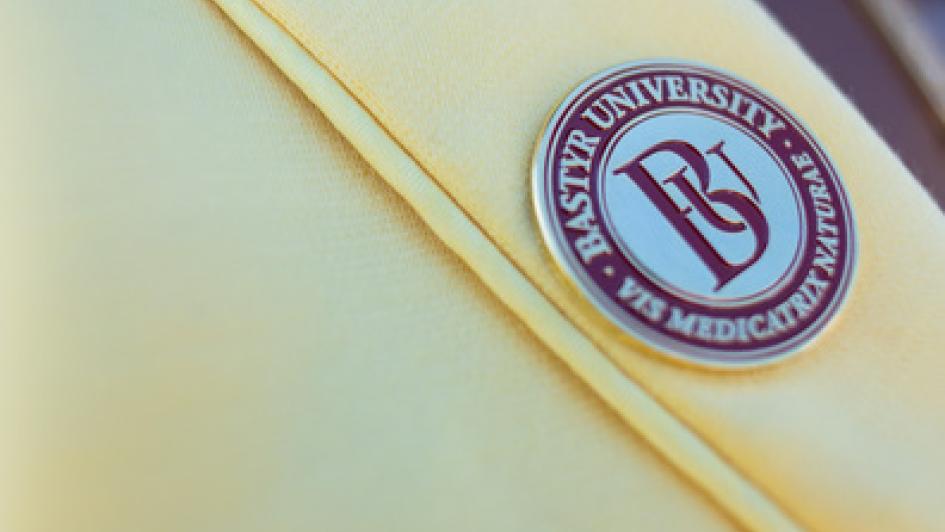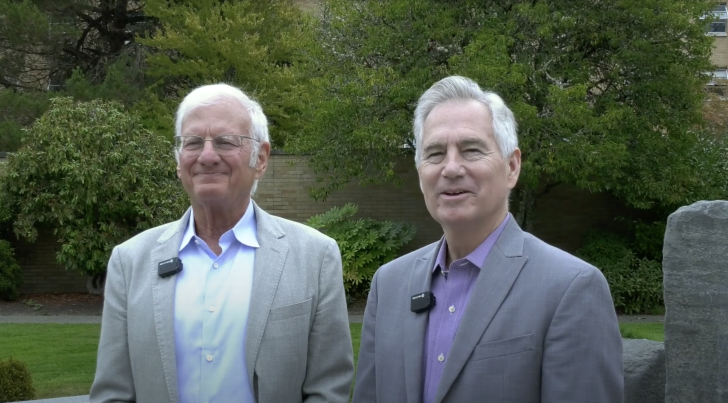Finding a Teaching Tool in Alex Grey's Sacred Art

Published
Healing is all about bodies, as any Bastyr University student can tell you. But what exactly is a body? A collection of molecules? An assemblage of organs and tissue wrapped in skin? A sacred, mysterious pulsating energy?
All of these and more, says Leanna Standish, PhD, ND, LAc, FABNO, a professor in Bastyr's School of Naturopathic Medicine. Part of her job is helping students understand the multiple dimensions of the body. To do this, she uses an unusual teaching tool: the paintings of artist Alex Grey.
Grey's Sacred Mirrors series features 21 life-sized paintings depicting numerous “layers” of the self. One shows a skeleton, another a nervous system, another the red arteries and blue veins of the cardiovascular system. Other layers may be less familiar to anatomy students: In the painting "Psychic Energy System," a body radiates ethereal light. In "Spiritual Energy System," a figure dissolves in a web of fizzing colorful energy.
Dr. Standish shows these images in the classroom to help students expand their understanding of what "self" can mean.
"It's not that one perspective is the better or superior view," she says of the different layers in Grey's art. "It's all true. But if you don't understand them all, you can never be a complete practitioner."
The paintings help her classes explore an important concept: vis medicatrix naturae — Latin for the body's natural ability to heal.
"The vis is the core radical philosophy of Bastyr University," Dr. Standish says. "But where is it? Does it come from the minerals that make up the body? Or the elements? Or does it come from the organs smoothly functioning together? Or does it come from a higher dimension, like God?"
Dr. Standish imagines Grey's paintings on a spectrum. Some students need to learn to consider the possibility of the spiritual realm, she says. Others need to remember that a spiritual approach to healing requires a foundation of scientific medical training. Learning mental flexibility is good for everyone in the classroom, herself included, she says.
"What I've realized in all of us is that we can get locked into one perspective," she says. "In graduate school, I was taught that the body is made of chemicals and cells that interact with each other, and nothing more. The rest of my life has been spent questioning that and finding out it's not so."
Much of Dr. Standish's research integrates scientific and spiritual perspectives on the self. As the lead investigator on studies into qigong and brain cancer, she measures a meditation healing practice with function magnetic resonance imaging (fMRI). As the medical director of the Bastyr Integrative Oncology Center, she studies cancer patients who receive both conventional treatments like chemotherapy and mind-body techniques like meditation. As a clinical professor at the University of Washington School of Public Health, she collaborates with medical professionals in a range of specialties.
Grey explores similar themes through Sacred Mirrors, a series he began some 30 years ago. The collection is the focus of a “Chapel of Sacred Mirrors” retreat Grey and his wife are building in upstate New York. His work has been described as psychedelic, postmodern, visionary, sacred and New Age. It is also meticulous. Grey used his experience as a medical illustrator to bring breathtaking precision to blood vessels, muscle tissues and hair follicles, drawing viewers with their detail (He's not the 19th century creator of the Gray's Anatomy textbook).
"His paintings have an uncanny effect on viewers, making them sense — or at least consider the possibility of — the subtle energies that surround us and how these personal force fields might change depending on our intention, actions and moods," says one critic.
Bastyr naturopathic medicine student Anup Mulakaluri has seen Dr. Standish present the paintings in her Physics and Biology of Consciousness class. "I found the ideas overwhelming at first, but then it clicked that this is what integrative medicine is about," he says. "You can consider the biochemical perspective, and also meridians and qi energy, and also something else. They're all perspectives on the same things."
Bastyr naturopathic medicine students take basic sciences courses equivalent to those in other medical schools, studying biochemistry, anatomy and physiology, disease pathology and other topics. Many students are also interested in how different understandings of consciousness apply to health and well-being.
"There's so much interest now among students in energy medicine," Dr. Standish says. "It used to be considered the most 'fringe' of what Bastyr does. But I think it's going to turn out to be the cutting edge of medicine."
When she spoke at a Bastyr conference for mental health professionals this spring, she emphasized the importance of an integrative approach for practitioners.
"The modern psychiatrist must think both neurologically and shamanically," she said. "If you do one without the other, you will never be a great healer."
Learn more about Bastyr's natural medicine programs.


